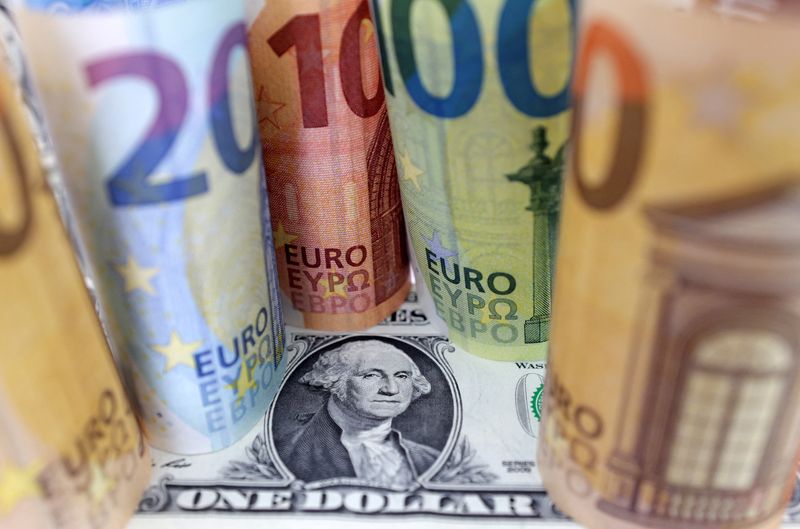Forex
Dollar gains on euro before Fed meeting


© Reuters. FILE PHOTO: U.S. Dollar and Euro banknotes are seen in this illustration taken July 17, 2022. REUTERS/Dado Ruvic/Illustration/File Photo
By Karen Brettell and Samuel Indyk
NEW YORK (Reuters) -The dollar gained against the euro on Monday as investors prepared for the prospect that the Federal Reserve could push back against expectations of an imminent rate cut when it concludes its two-day meeting on Wednesday.
Traders have cut odds that the U.S. central bank will reduce rates in March to 48%, from 89% a month ago, according to the CME Group’s FedWatch Tool, as data reinforces a view that the U.S. economy remains solid.
That also contrasts to a weaker economic outlook for European countries, which is making the single currency relatively less attractive.
“The macro picture in the U.S. looks a lot better than the macro picture in European union countries and the eurozone in general,” said Helen Given, FX trader at Monex USA in Washington.
The Fed is expected to hold rates steady on Wednesday and investors will focus on comments from Fed Chairman Jerome Powell, after he indicated in December that the Fed is pivoting to a rate cutting cycle.
“We’ll probably see a bit of pushback on the last meeting,” said Given. “I’d expect that a lot of the dollar strength that we’re seeing today, and we should continue to see until that decision release on Wednesday, is coming from shifting expectations.”
The euro dipped 0.20% to $1.08290 and earlier reached $1.07955, the lowest since Dec. 13.
The European Central Bank on Thursday held interest rates at a record-high 4% and reaffirmed its commitment to fighting inflation even as the time to start easing borrowing costs approaches.
“ECB President Christine Lagarde emphasized during her press conference that the debate over rate cuts was premature but reiterated that borrowing costs could be lowered from the summer. Lagarde also did not lean against aggressive money market expectations of the ECB’s easing cycle,” said Win Thin, global head of currency strategy at Brown Bothers Harriman, in a note.
ECB policymakers speaking on Monday disagreed on the exact timing of a cut or the trigger for action.
Traders are now fully pricing a move in April, with almost 150 basis points of easing priced in for the year.
The , which measures the U.S. currency against six rivals, was last down 0.05% at 103.50. It earlier reached 103.82, matching last week’s high, which was the highest since Dec. 13.
The index fell in afternoon trading in line with Treasury yields after the U.S. Treasury said it expects to borrow $760 bln in the first quarter, $55 bln lower than its October estimate.
Sterling was little changed on the day at $1.27050 ahead of the Bank of England’s policy announcement on Thursday.
The greenback fell 0.45% to 147.45 yen, but the Japanese currency is on course for a 4.5% decline in January as traders temper their expectations of when the Bank of Japan would exit from its ultra-loose policy.
Investors are also wary of growing geopolitical risks after three U.S. service members were killed in an aerial drone attack on U.S. forces in northeastern Jordan near the Syrian border.
Such uncertainties could provide the safe-haven yen with a temporary lift, analysts said.
In cryptocurrencies, gained 2.62% to $43,087.

 Forex3 years ago
Forex3 years agoForex Today: the dollar is gaining strength amid gloomy sentiment at the start of the Fed’s week

 Forex3 years ago
Forex3 years agoUnbiased review of Pocket Option broker

 Forex3 years ago
Forex3 years agoDollar to pound sterling exchange rate today: Pound plummeted to its lowest since 1985

 Forex3 years ago
Forex3 years agoHow is the Australian dollar doing today?

 Cryptocurrency3 years ago
Cryptocurrency3 years agoWhat happened in the crypto market – current events today

 World3 years ago
World3 years agoWhy are modern video games an art form?

 Commodities3 years ago
Commodities3 years agoCopper continues to fall in price on expectations of lower demand in China

 Economy3 years ago
Economy3 years agoCrude oil tankers double in price due to EU anti-Russian sanctions





















